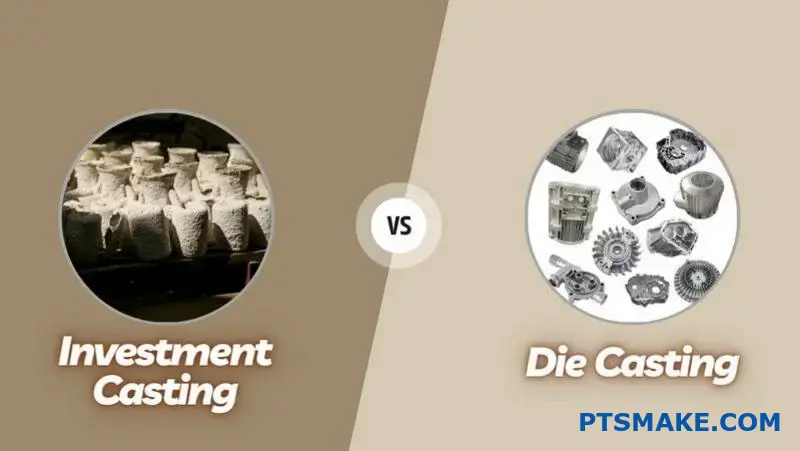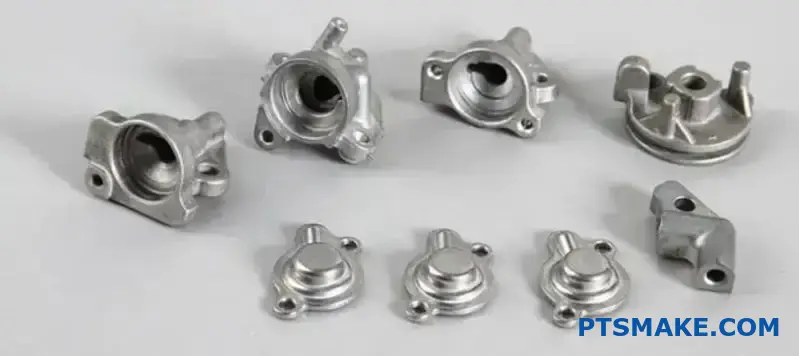Qu'est-ce que l'usinage CNC à haut volume ?
Vous est-il déjà arrivé d'avoir besoin de milliers de pièces identiques et de constater que l'augmentation de la production entraîne des incohérences et une augmentation des coûts ? Le prototype initial était parfait, mais la production en série représente un tout autre défi.
L'usinage CNC en grande série est un processus de fabrication qui utilise des équipements automatisés et contrôlés par ordinateur pour produire rapidement de grandes quantités de pièces identiques. C'est la méthode idéale pour atteindre la précision, la cohérence et la rentabilité lorsque l'on passe du prototype à la production à grande échelle.
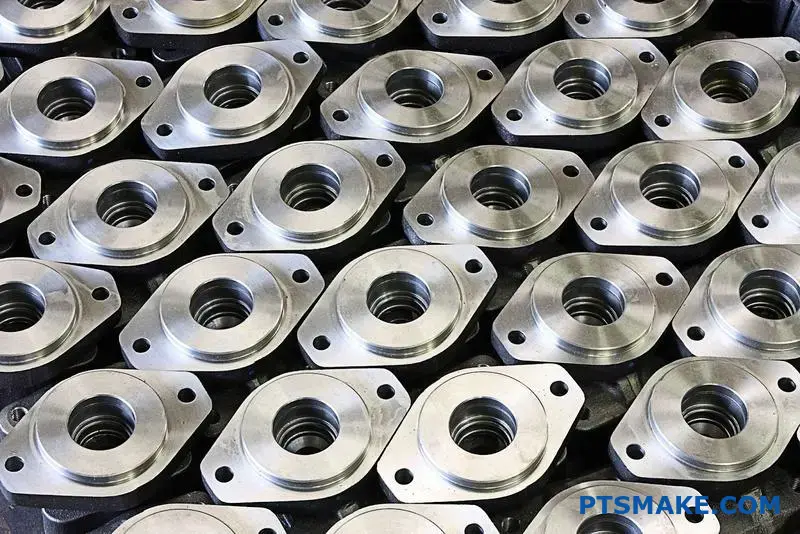
Au fond, l'usinage CNC en grande série est une question d'efficacité et de répétabilité. Le processus s'appuie fortement sur l'automatisation pour minimiser l'intervention humaine et maximiser le rendement. Une fois qu'une machine CNC est programmée et outillée pour une pièce spécifique, elle peut fonctionner en continu, produisant des milliers de composants qui sont pratiquement impossibles à distinguer les uns des autres. Cela diffère fondamentalement de l'usinage de faibles volumes ou de prototypes, où les réglages sont fréquents et où l'accent est mis sur la flexibilité plutôt que sur la vitesse. L'objectif principal est ici de réduire la Durée du cycle1 pour chaque partie autant que possible.
Principales différences : Volume élevé et volume faible
| Fonctionnalité | Usinage à haut volume | Usinage à faible volume |
|---|---|---|
| Quantité | de 1 000 à 1 000 000+ | 1 à 1 000 |
| Coût par pièce | Très faible | Élevée à moyenne |
| Coût de la mise en place | Haut | Faible |
| Délai d'exécution | Plus long au départ, plus rapide à l'arrivée | Configuration initiale rapide |
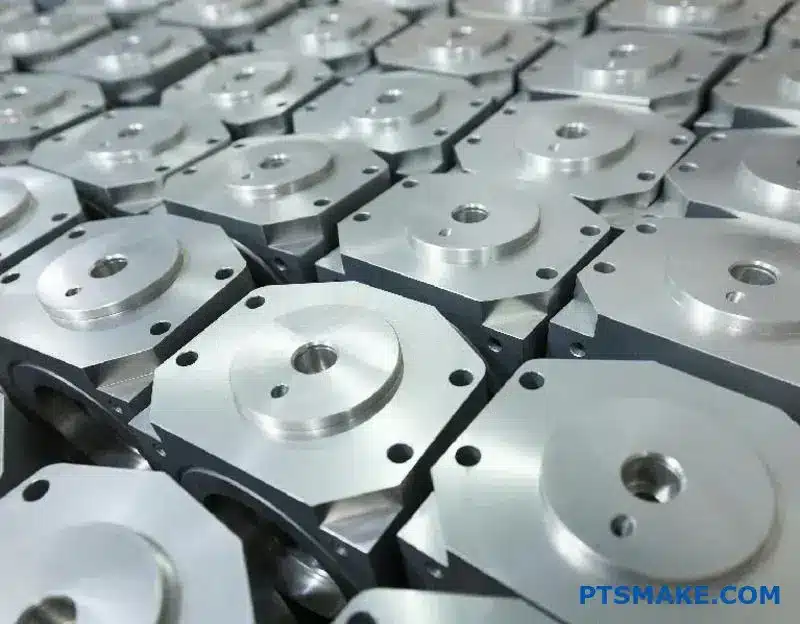
Pourquoi les entreprises choisissent-elles cette méthode ? Le principal facteur est l'économie d'échelle. Bien que l'investissement initial dans la programmation, les montages personnalisés et l'outillage soit plus élevé, le coût par pièce individuelle diminue de manière significative à mesure que le volume de production augmente. Dans les projets que nous avons traités chez PTSMAKE, cette méthode devient le choix le plus logique lorsqu'une entreprise a validé sa conception et est prête à entrer sur le marché à grande échelle. Il s'agit d'une décision stratégique qui permet d'équilibrer les coûts initiaux avec les économies à long terme et l'efficacité de la production.
Quand choisir l'usinage CNC à haut volume
Scénarios idéaux
- Lancement du produit : Lorsqu'il s'agit d'introduire un nouveau produit sur un marché de masse.
- Demande stable : Pour les pièces faisant l'objet d'une demande constante et permanente.
- Réduction des coûts : Pour réduire le coût unitaire d'un composant éprouvé.
Cette approche est cruciale pour des secteurs tels que l'automobile, l'électronique grand public et les appareils médicaux, où de grandes quantités de pièces de haute précision sont une exigence constante des chaînes de montage.
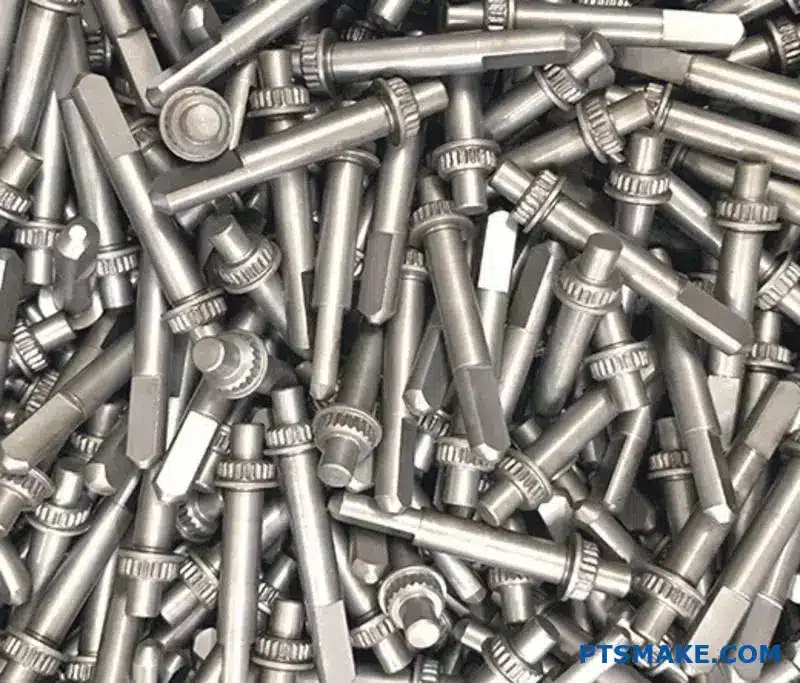
L'usinage CNC en grande série utilise l'automatisation pour produire efficacement des milliers de pièces précises et identiques. Bien qu'elle implique des coûts d'installation initiaux plus élevés, cette méthode permet de réaliser d'importantes économies d'échelle, ce qui réduit considérablement le prix unitaire pour les grandes séries où l'uniformité est primordiale.
Principaux avantages pour les responsables de la fabrication ?
Vous êtes confronté à une qualité irrégulière et à des délais de livraison imprévisibles pour les grandes séries de production ? Ces problèmes font-ils constamment dérailler votre budget et vos calendriers de livraison, créant ainsi un stress inutile pour votre équipe ?
L'usinage CNC en grande série relève directement ces défis en offrant une vitesse inégalée, une qualité constante et une rentabilité importante. Il réduit considérablement les délais, minimise les variations d'une pièce à l'autre et abaisse le coût unitaire, tout en respectant scrupuleusement vos spécifications.
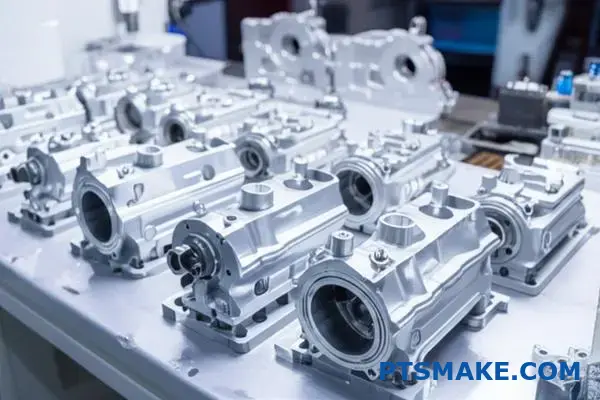
Rapidité et cohérence grâce à l'automatisation
Le principal avantage de l'usinage CNC en grande série réside dans son automatisation. Une fois qu'un programme est chargé, une machine peut fonctionner en continu, ce qui réduit considérablement les délais de production. Cette même automatisation est la clé de la qualité. Chaque pièce est produite à partir du même fichier numérique, ce qui élimine l'erreur humaine et la variabilité communes aux processus manuels. La qualité de la machine est ainsi garantie. précision volumétrique2 se traduit dans chaque composant, garantissant que chaque pièce, de la première à la dix-millième, répond aux spécifications requises sans déviation. Cet aspect est fondamental pour toute production à grande échelle où la cohérence n'est pas négociable.
| Métrique | Opérations manuelles | Usinage CNC à haut volume |
|---|---|---|
| Cohérence d'une partie à l'autre | Faible | Extrêmement élevé |
| Vitesse de production | Lenteur | Rapide |
| Risque d'erreur | Haut | Très faible |
| Intensité du travail | Haut | Faible (surveillance) |
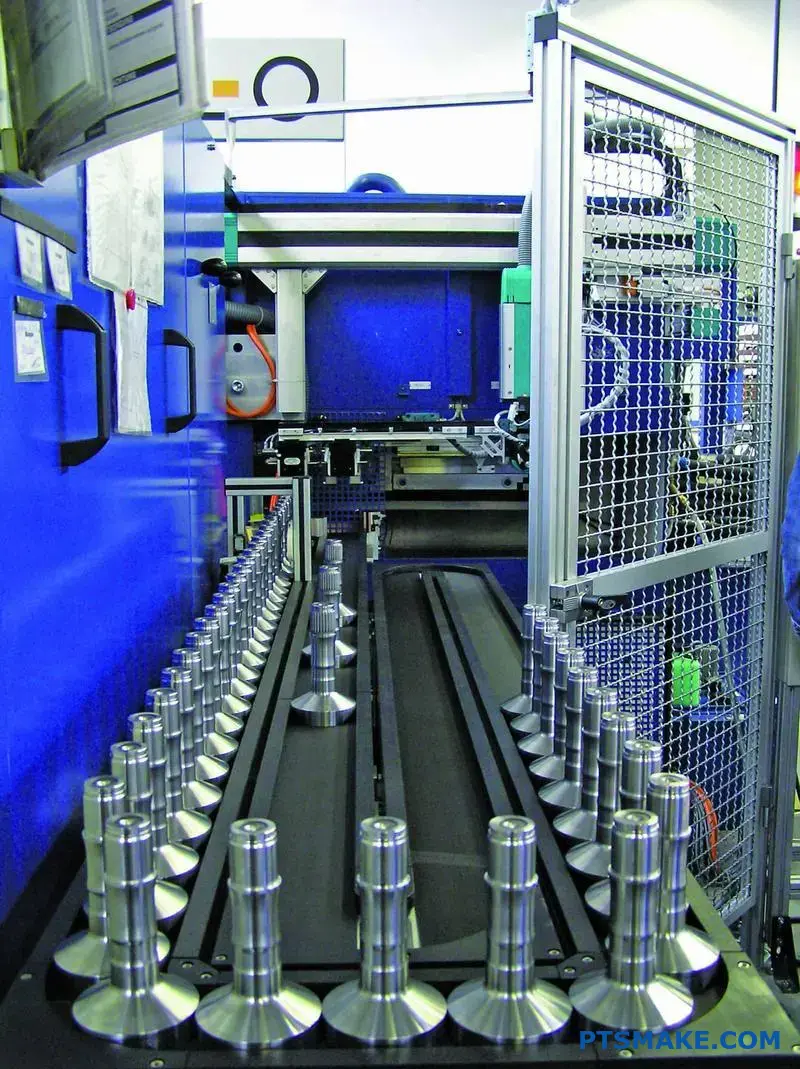
Rentabilité et évolutivité
Bien qu'il y ait un investissement initial dans la programmation et la configuration, le coût par pièce de l'usinage CNC en grande série diminue considérablement à mesure que la quantité augmente. Ce principe d'économie d'échelle est puissant. L'automatisation réduit les coûts de main-d'œuvre directe, les parcours d'outils optimisés minimisent le gaspillage de matériaux et la régularité exceptionnelle élimine presque toutes les dépenses liées aux rebuts ou aux retouches. C'est donc un choix financièrement judicieux pour les commandes importantes. En outre, l'évolutivité est intégrée au processus. Une fois qu'un programme est validé, il suffit de l'exécuter sur un plus grand nombre de machines ou pendant de plus longues heures pour augmenter la production. Dans le cadre de notre travail à PTSMAKE, nous guidons fréquemment nos clients d'un prototype vérifié à une production à grande échelle en utilisant la même conception numérique, ce qui garantit une montée en puissance prévisible et efficace.
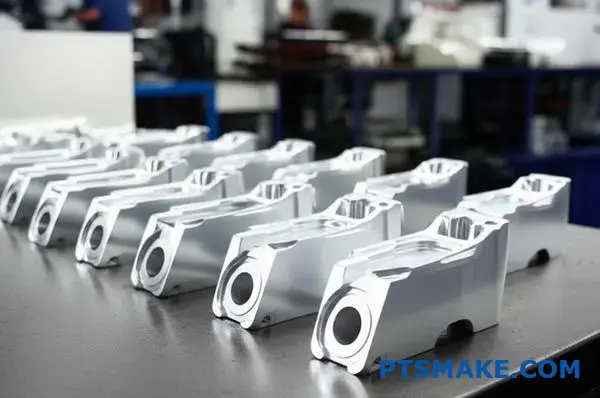
Pour les responsables de la fabrication, l'usinage CNC en grande série offre un mélange puissant d'avantages. Il offre une rapidité et une qualité inébranlable grâce à l'automatisation, réduit les coûts par pièce et permet une évolutivité sans faille pour répondre aux fluctuations de la demande, ce qui en fait la pierre angulaire d'une production moderne et efficace.
Industries qui dépendent de l'usinage CNC à haut volume ?
Vous êtes-vous déjà demandé comment les industries qui exigent des millions de pièces identiques et parfaites parviennent à se développer ? Pour elles, un seul défaut n'est pas seulement un défaut, c'est une défaillance critique aux conséquences graves.
L'usinage CNC en grande série est l'épine dorsale de secteurs critiques tels que l'aérospatiale, l'automobile, la médecine et l'électronique. Ces industries en dépendent pour produire des quantités massives de composants extrêmement précis, fiables et complexes, essentiels à la sécurité, aux performances et à l'innovation.
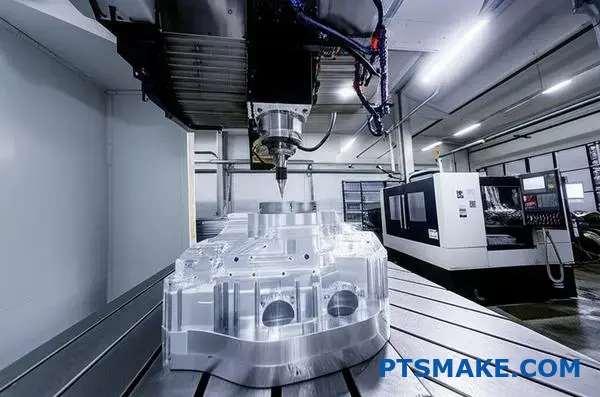
La demande de précision est incessante dans les secteurs où l'échec n'est pas une option. L'usinage CNC à grande échelle relève ce défi en assurant la cohérence de millions de pièces. C'est la raison pour laquelle PTSMAKE a investi massivement dans cette technologie.
Aérospatiale : Repousser les limites de la précision
Dans l'aérospatiale, chaque composant, des pales de turbines aux pièces de trains d'atterrissage, doit répondre à des spécifications extrêmes. Cette industrie fait appel à l'usinage CNC pour sa capacité à travailler avec des alliages avancés et à créer des géométries complexes avec des tolérances serrées, afin de garantir la navigabilité de chaque pièce. Tous les détails la traçabilité des matériaux3 est également obligatoire.
Automobile : L'efficacité à grande échelle
L'industrie automobile a besoin de millions de pièces fiables chaque année, des blocs moteurs aux composants de transmission. L'usinage CNC en grande série offre la vitesse et la répétabilité nécessaires à cette échelle, ce qui permet de maintenir les lignes de production en mouvement et les coûts compétitifs.
| L'industrie | Exigence clé | Matériaux communs |
|---|---|---|
| Aérospatiale | Précision et fiabilité extrêmes | Titane, Inconel, Alliages d'aluminium |
| Automobile | Évolutivité et rentabilité | Acier, aluminium, fonte |
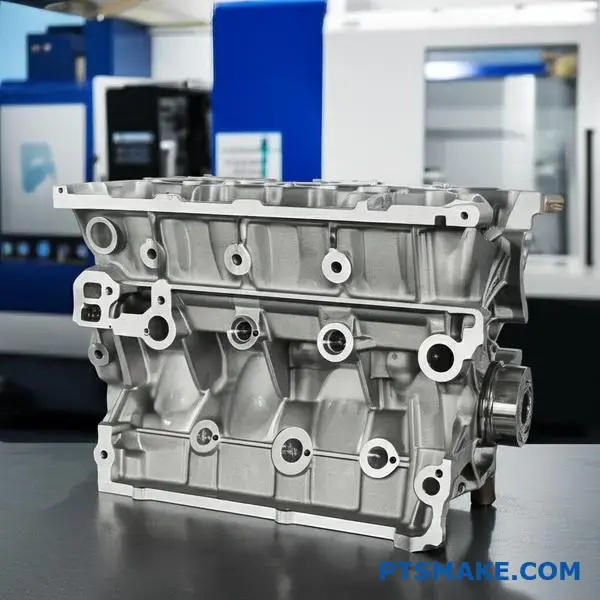
Le besoin de précision en grande quantité va bien au-delà des transports. D'après notre expérience, les secteurs de la médecine et de l'électronique dépendent aussi fortement de ce processus pour l'innovation et la fiabilité.
Dispositifs médicaux : L'usinage au service de la santé et de la sécurité
Qu'il s'agisse d'outils chirurgicaux personnalisés ou d'implants vitaux tels que les stimulateurs cardiaques, le domaine médical exige une perfection absolue. L'usinage CNC est essentiel pour créer ces dispositifs complexes à partir de matériaux biocompatibles tels que le titane et le PEEK, afin de garantir qu'ils sont sûrs et efficaces pour les patients, tout en respectant des normes réglementaires strictes.
L'électronique : L'échelle de la miniaturisation
Si vous regardez à l'intérieur d'un smartphone ou d'un ordinateur portable, vous y trouverez d'innombrables composants minuscules et complexes. L'usinage CNC en grande série produit les boîtiers métalliques, les connecteurs et les dissipateurs thermiques qui sont essentiels à la performance et à la durabilité de l'électronique grand public moderne, répondant ainsi à une demande mondiale massive.
| L'industrie | Exigence clé | Matériaux communs |
|---|---|---|
| Médical | Biocompatibilité et stérilisation | Titane, PEEK, acier inoxydable |
| Électronique | Miniaturisation et esthétique | Aluminium, cuivre, plastiques |
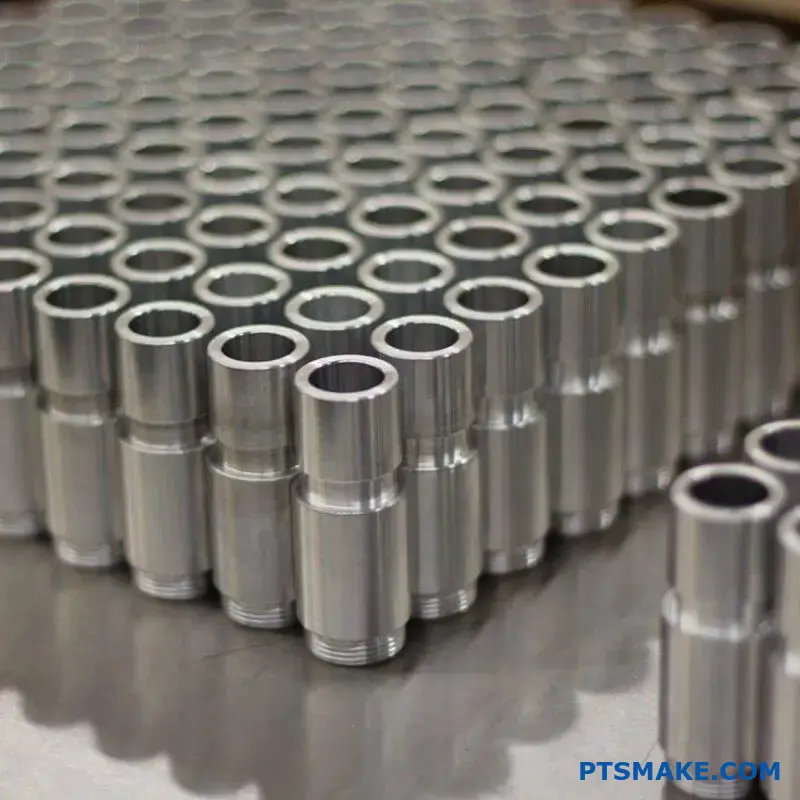
Des composants aérospatiaux aux implants médicaux, les industries s'appuient sur l'usinage CNC en grande série pour sa précision et son évolutivité inégalées. Ce processus est essentiel pour créer les composants complexes et fiables qui sont le moteur de la technologie moderne et qui garantissent la sécurité des applications critiques dans le monde entier.
Garantir la qualité et la cohérence des grandes séries ?
Vous êtes-vous déjà inquiété que la dix millième pièce ne soit pas identique à la première ? Cette crainte peut mettre en péril des chaînes de production entières et nuire à la réputation de votre marque.
Nous y parvenons grâce à des systèmes rigoureux de contrôle de la qualité. Il s'agit d'une combinaison de surveillance en cours de fabrication, de protocoles d'inspection détaillés et de l'utilisation d'une technologie CNC avancée pour maintenir des tolérances serrées et éliminer la variabilité sur chaque pièce d'un cycle de production à grand volume.
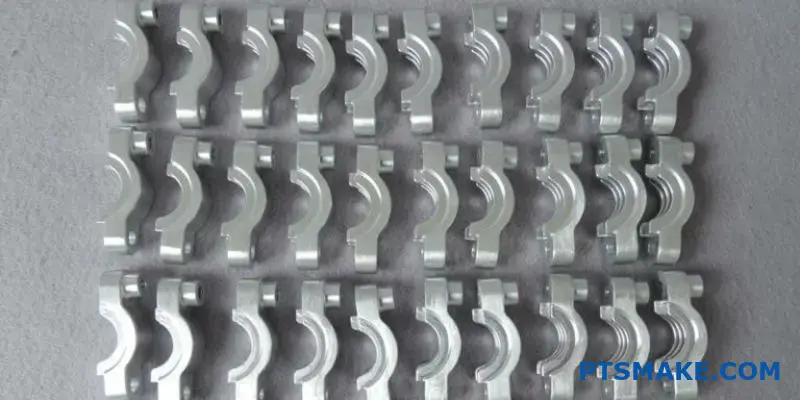
La qualité dans l'usinage CNC à haut volume n'est pas accidentelle, elle est conçue. Chez PTSMAKE, notre approche commence par un solide plan de qualité pour chaque projet. Il ne s'agit pas d'un simple contrôle final, mais d'un processus continu intégré à la production.
Protocoles d'inspection proactive
Nous mettons en œuvre une stratégie d'inspection en plusieurs étapes. Elle commence par une inspection complète du premier article (FAI) pour vérifier la configuration. Une fois la production lancée, nous utilisons l'échantillonnage statistique pour vérifier les pièces à intervalles réguliers, ce qui garantit la cohérence du début à la fin. La science de l'inspection Métrologie4 est fondamental pour l'ensemble du processus, car il garantit la précision et la fiabilité de chaque mesure.
| Phase d'inspection | Objectif | Outils clés |
|---|---|---|
| Premier article | Vérifier la configuration et le programme | MMT, pieds à coulisse, jauges |
| En cours | Contrôler la cohérence | Comparateur optique, jauges |
| AQ finale | Confirmer la qualité globale | Tous les outils disponibles |
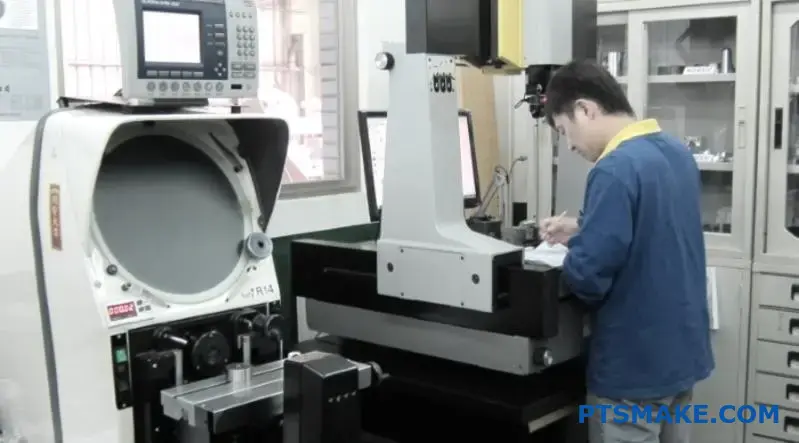
Les machines CNC modernes sont essentielles au maintien de la cohérence dans la production à grande échelle. Elles ne se contentent pas de suivre un programme statique ; ce sont des systèmes dynamiques qui gèrent et corrigent activement les écarts potentiels, ce qui est crucial pour les projets exigeants.
Le rôle des systèmes CNC avancés
Nos systèmes avancés utilisent des boucles de rétroaction pour éliminer la variabilité avant qu'elle ne devienne un problème.
Ajustements en temps réel
Des capteurs surveillent en temps réel des facteurs tels que l'usure de l'outil et la dilatation thermique. Le système de commande de la machine procède alors automatiquement à des micro-ajustements de la trajectoire de coupe ou de la vitesse de la broche. Cette approche proactive garantit que chaque pièce reste dans les tolérances étroites spécifiées, un aspect non négociable de l'usinage CNC en grande série.
| Fonctionnalité | Anciens systèmes CNC | Systèmes CNC avancés |
|---|---|---|
| Usure des outils | Contrôles manuels | Compensation automatisée |
| Précision de positionnement | Estimation en boucle ouverte | Rétroaction en boucle fermée |
| Contrôle des processus | En fonction de l'opérateur | Ajustements pilotés par le système |
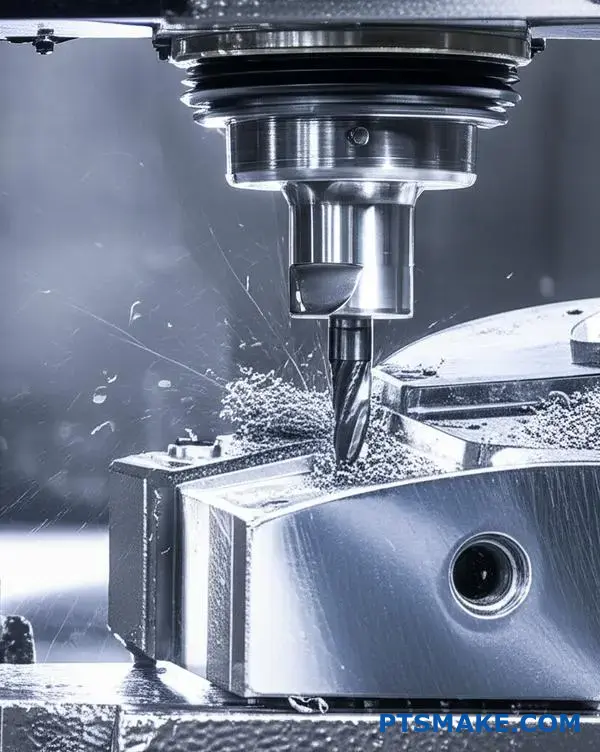
Pour garantir la cohérence des grandes séries, il est essentiel d'adopter une double approche. Des protocoles d'inspection rigoureux constituent le cadre, tandis que des systèmes CNC avancés, dotés de capacités de surveillance en temps réel et d'autocorrection, éliminent activement la variabilité, garantissant que chaque pièce répond exactement aux spécifications, de la première à la dernière.
Stratégies de réduction des coûts pour les projets CNC à grand volume ?
Vous battez-vous constamment pour réduire les coûts unitaires de vos projets à grand volume ? Les petites inefficacités négligées semblent-elles s'accumuler, érodant progressivement vos marges bénéficiaires sur une longue période de production ?
Les stratégies efficaces de réduction des coûts pour l'usinage CNC en grande série impliquent une approche proactive. En mettant en œuvre une maintenance préventive, en investissant dans un outillage de haute qualité, en optimisant les flux de production et en exploitant stratégiquement l'automatisation, vous pouvez réduire de manière significative les coûts unitaires sans compromettre la qualité ou allonger les délais.
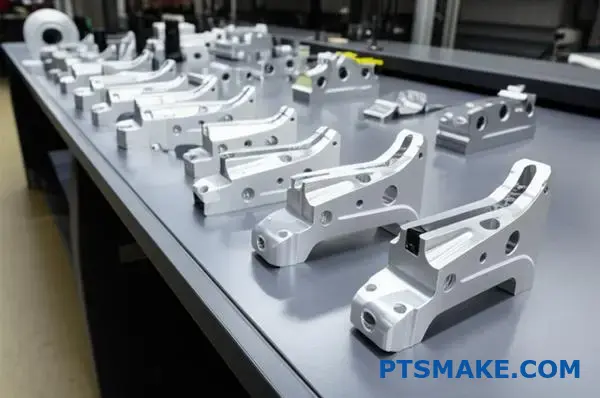
Pour véritablement contrôler les coûts dans la production à haut volume, il faut regarder au-delà du prix des matières premières. C'est l'efficacité opérationnelle - ou son absence - qui a souvent l'impact le plus important. Négliger l'entretien régulier des équipements entraîne des temps d'arrêt imprévus, ce qui est désastreux pour les calendriers de production serrés. D'après notre expérience, un programme d'entretien proactif est beaucoup moins coûteux que des réparations d'urgence réactives. De même, le choix d'un outillage moins cher et moins durable est une fausse économie. Il entraîne des remplacements fréquents, une augmentation des arrêts machine et des défauts potentiels des pièces. Comprendre les Temps moyen entre les défaillances (MTBF)5 de votre équipement et de vos outils est fondamentale pour construire une ligne de production fiable et rentable.
Maintenance préventive ou réparations réactives
Un plan de maintenance structuré est essentiel. Il permet de minimiser les arrêts de production imprévus, qui sont particulièrement coûteux dans le cas de l'usinage CNC à haut volume.
| Type de maintenance | Impact sur les coûts | Impact de la production |
|---|---|---|
| Préventive | Prévisibilité et réduction des coûts | Temps d'arrêt programmé, perturbation minimale |
| Réactif | Coût élevé et imprévisible | Temps d'arrêt imprévu, perturbation majeure |
La valeur d'un outillage durable
L'investissement dans un outillage durable et de qualité supérieure porte ses fruits en réduisant la fréquence des changements d'outils et en améliorant l'uniformité des pièces.
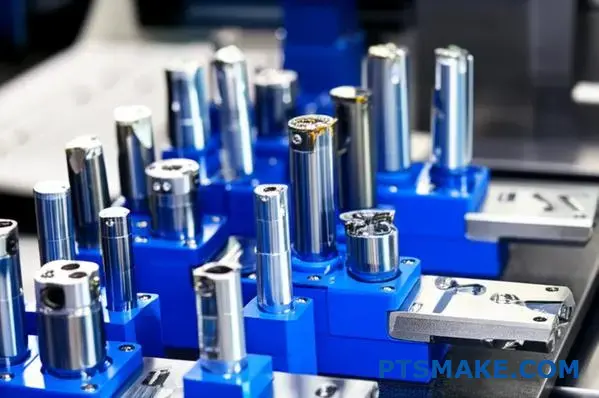
Au-delà de la maintenance et de l'outillage, l'optimisation et l'automatisation des flux de travail sont les prochaines frontières de la réduction des coûts. Un flux de travail rationalisé élimine les goulets d'étranglement et les mouvements inutiles, en veillant à ce que chaque étape, de la manutention des matériaux à l'inspection finale, soit aussi efficace que possible. Chez PTSMAKE, nous analysons en permanence notre flux de production pour réduire les temps de cycle de quelques secondes, ce qui se traduit par des économies substantielles sur les grosses commandes. L'automatisation, qu'il s'agisse de bras robotisés pour le chargement/déchargement ou de contrôles de qualité automatisés, renforce encore cette efficacité. Elle réduit les coûts du travail manuel et minimise le risque d'erreur humaine, garantissant ainsi une qualité constante sur des dizaines de milliers de pièces. C'est ainsi que la fabrication moderne atteint l'évolutivité et la rentabilité.
Optimiser les flux de production
Il est essentiel d'identifier et de résoudre les goulets d'étranglement. Un retard à un poste peut entraîner l'arrêt de toute la chaîne de production.
| Stratégie | Bénéfice principal | Exemple |
|---|---|---|
| Analyse des flux de travail | Réduction du temps de cycle | Réorganisation des parcours d'outils pour des coupes plus rapides |
| Automatisation | Cohérence accrue | Utilisation d'un cobot pour le chargement répétitif de pièces |
Tirer parti de l'automatisation
L'automatisation réduit la dépendance à l'égard de la main-d'œuvre et augmente le rendement, ce qui la rend idéale pour les projets d'usinage CNC à grand volume.
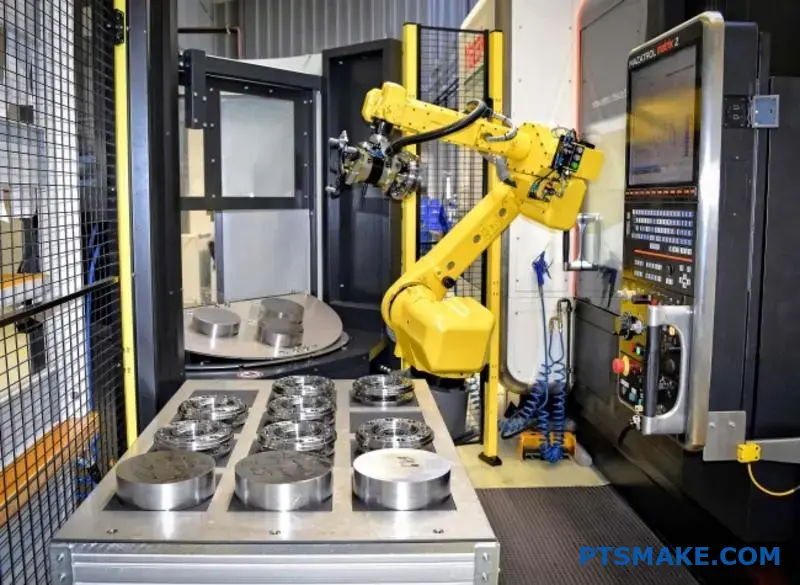
Pour réduire les coûts des projets CNC à grand volume, il faut se concentrer sur des stratégies proactives. La mise en œuvre d'une maintenance préventive, l'utilisation d'un outillage durable, l'optimisation des flux de travail et l'exploitation de l'automatisation réduiront votre coût unitaire tout en maintenant la qualité et la rapidité attendues par vos clients.
Comment sélectionner le bon matériau et le bon partenaire pour les pièces complexes ?
Vous êtes-vous déjà sentis coincés entre les propriétés idéales d'un matériau et sa fabricabilité ? Un mauvais choix de matériau ou de fournisseur peut mettre en péril l'ensemble de votre production en grande série.
Pour choisir le bon matériau, vous devez analyser ses propriétés mécaniques, thermiques et chimiques en fonction de vos besoins de conception. Pour choisir un partenaire, vérifiez ses capacités techniques, ses processus de contrôle de la qualité et son expérience avérée dans l'usinage CNC en grande série de pièces comme les vôtres.
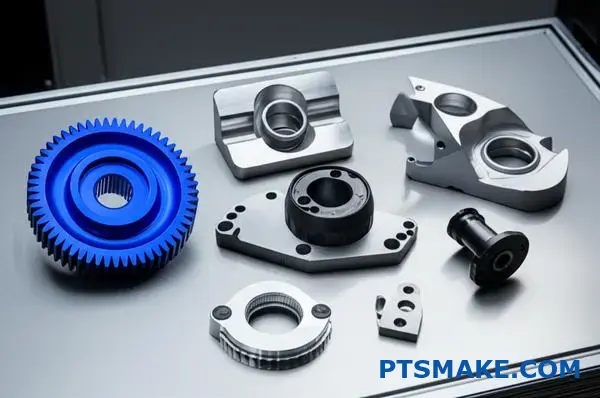
Il est fondamental de faire le bon choix de matériau. Il ne s'agit pas simplement de choisir une substance, mais de définir les performances, la durée de vie et le coût de la pièce. Il s'agit d'un exercice d'équilibre qui nécessite une connaissance approfondie des options disponibles.
Critères clés de sélection des matériaux
Besoins mécaniques et thermiques
Tenez compte des forces et des températures que la pièce devra supporter. Aura-t-elle besoin d'une grande résistance à la traction comme l'acier, ou la légèreté de l'aluminium est-elle plus importante ? Pour les composites, il faut comprendre leur propriétés anisotropes6 est essentiel, car leur force peut varier en fonction de la direction de la force.
Productibilité vs. coût
Certains matériaux à hautes performances sont notoirement difficiles à usiner, ce qui augmente les temps de cycle et les coûts, en particulier pour les gros volumes. Nous aidons souvent nos clients à trouver un matériau qui réponde à 95% de leurs spécifications de performance idéales, mais qui soit 30% plus facile à usiner.
| Matériau | Caractéristiques principales | Meilleur pour |
|---|---|---|
| Aluminium 6061 | Excellent rapport résistance/poids | Cadres pour l'aérospatiale et l'automobile |
| Acier inoxydable 304 | Haute résistance à la corrosion | Matériel médical et alimentaire |
| PEEK | Performance à haute température | Pièces industrielles exigeantes |
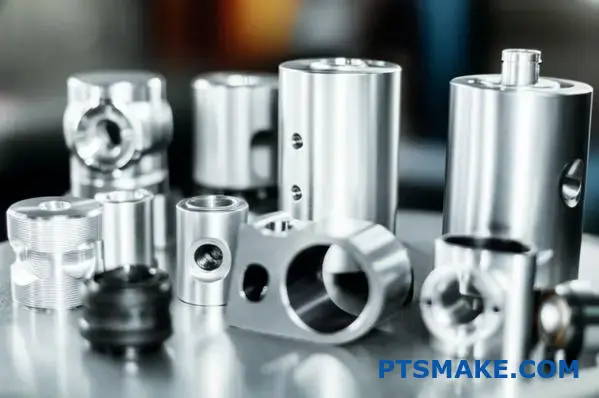
Une fois le matériau choisi, le choix du partenaire est tout aussi crucial. Le meilleur matériau entre les mains d'un fournisseur incapable se traduira par des pièces de rebut et des retards dans le projet. Un bon partenaire agit comme une extension de votre propre équipe d'ingénieurs.
Évaluer un partenaire pour l'usinage CNC
Expertise technique et équipement
Le partenaire potentiel dispose-t-il de la bonne technologie ? Pour les géométries complexes, l'usinage CNC à 5 axes n'est souvent pas négociable. Chez PTSMAKE, notre investissement dans des machines de pointe est motivé par les défis complexes que nous lancent nos clients. Demandez à voir leur liste d'équipements et à comprendre leurs capacités.
Systèmes de qualité et évolutivité
Comment garantissent-ils la qualité de la première à la dernière pièce dans le cadre d'une commande d'usinage CNC à grand volume ? Recherchez des systèmes de gestion de la qualité robustes, tels que la certification ISO 9001.
| Domaine d'évaluation | Ce qu'il faut rechercher | Pourquoi c'est important |
|---|---|---|
| Liste des équipements | Machines CNC à 5 axes | Permet la création de géométries complexes |
| Certificats de qualité | ISO 9001, AS9100 | Assurer la cohérence et la fiabilité du processus |
| Projets antérieurs | Portefeuille de pièces similaires | Preuve d'une expérience pratique et pertinente |
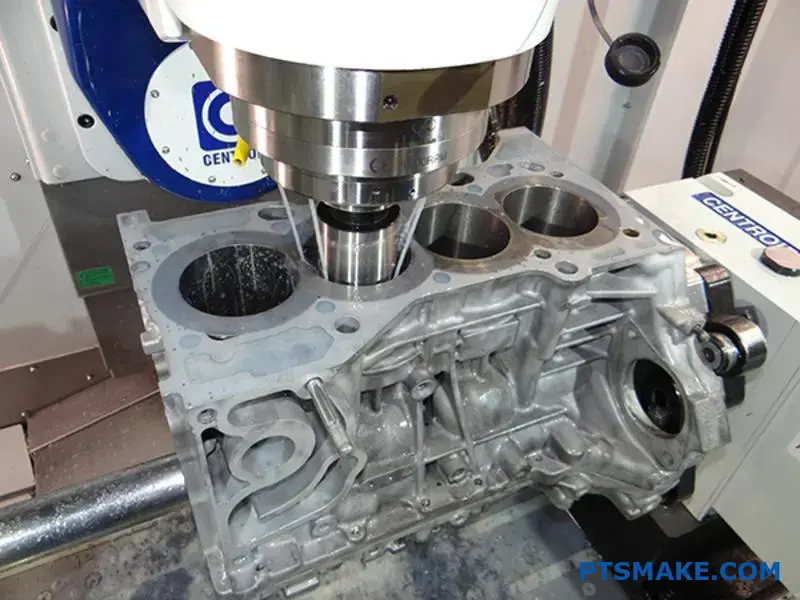
La réussite de la production de pièces complexes dépend de deux décisions clés : sélectionner le bon matériau en équilibrant les performances et la facilité de fabrication, et choisir un partenaire disposant de l'expertise technique et de systèmes de qualité éprouvés pour assurer des livraisons régulières, en particulier pour les commandes de gros volumes.
Comment choisir le bon partenaire pour l'usinage CNC ?
Vous vous sentez dépassé par la recherche d'un partenaire d'usinage CNC capable de s'adapter à votre projet, qu'il s'agisse d'un simple prototype ou de milliers d'unités ?
Pour choisir le bon partenaire, il faut évaluer son expérience en matière de commandes de gros volumes, ses équipements et ses systèmes de qualité, et s'assurer qu'il prend en charge l'ensemble du cycle de vie du produit, du prototypage à la production à grande échelle.
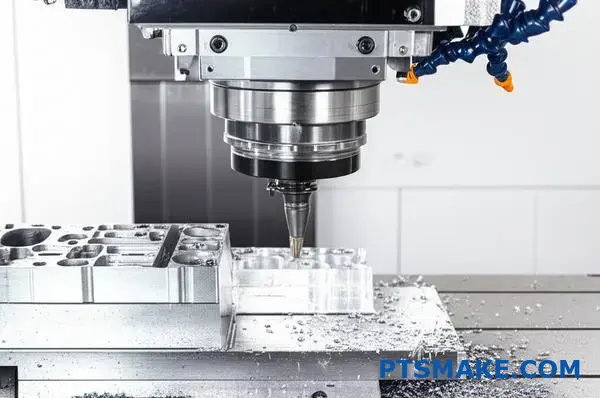
Lors de la sélection d'un fournisseur, il est essentiel de tenir compte de sa capacité à gérer des commandes à la fois de faible et de fort volume. Un partenaire qui excelle dans le prototypage, mais qui n'est pas à la hauteur de la production de masse, crée un goulot d'étranglement majeur. La transition doit être transparente. Pour ce faire, il faut non seulement des machines de pointe, mais aussi des processus établis pour l'évolutivité. D'après l'expérience de PTSMAKE, un véritable partenaire maintient une qualité et une précision constantes de la première à la dix-millième pièce. Il comprend que le succès d'un cycle d'usinage CNC à haut volume dépend des éléments suivants métrologie7 et les contrôles établis au cours de la phase initiale du prototype.
Évaluation des capacités de production
| Type de partenaire | Prototypage | Production en grande série |
|---|---|---|
| Spécialiste du prototypage | Excellent, délai d'exécution rapide | Manque de capacité, incohérence |
| Partenaire intégré | Cohérence avec la production | Évolutif, fiable, rentable |
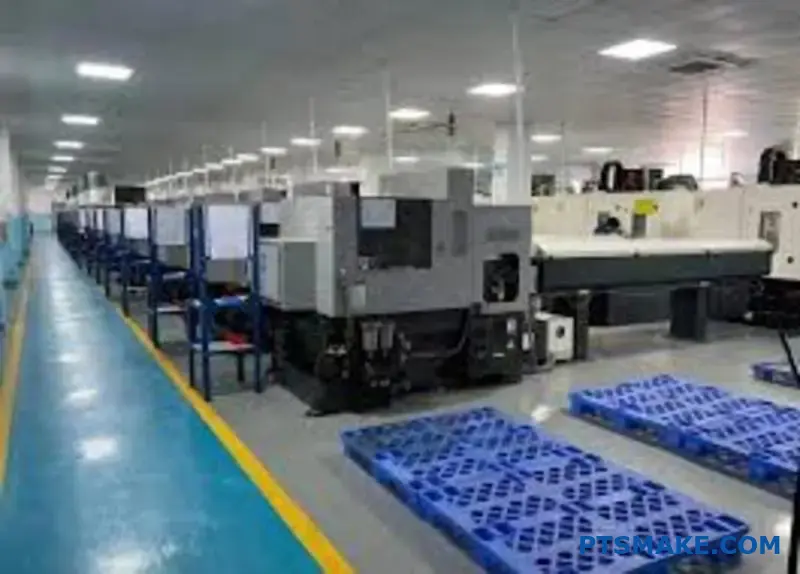
Au-delà de la capacité de production, vous devez examiner de près leur système de gestion de la qualité (SGQ) et leurs pratiques de communication. Un SMQ solide, souvent attesté par des certifications telles que ISO 9001, est la base d'une réussite répétée dans la fabrication en grande série. Toutefois, les certifications ne sont qu'un point de départ. Demandez des exemples concrets de leurs contrôles de processus et de leurs rapports sur la qualité. Une communication réactive est également essentielle. Un partenaire qui fournit des mises à jour claires et proactives peut éviter que des problèmes mineurs ne se transforment en retards importants. Cette transparence permet d'instaurer la confiance nécessaire à une relation à long terme, ce qui est un principe fondamental que nous respectons.
Attributs clés du fournisseur
Liste de contrôle de la qualité et de la communication
- Un système de gestion de la qualité robuste : Est-il certifié et, surtout, activement utilisé ?
- Contrôles des processus : Peuvent-ils démontrer comment ils maintiennent la cohérence ?
- Une communication claire : Sont-ils réactifs, transparents et proactifs ?
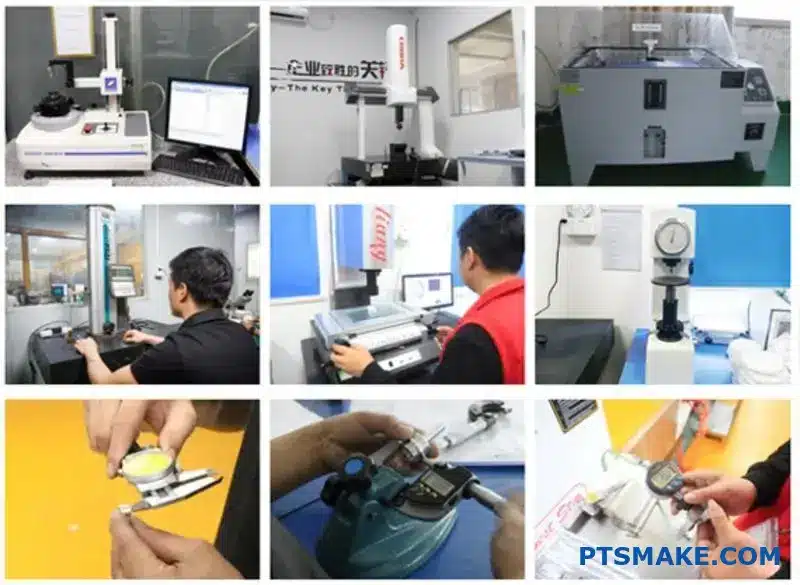
Pour choisir le bon partenaire d'usinage CNC, il faut vérifier sa capacité à s'adapter. Recherchez une expérience avérée de la production en grande série, des systèmes de qualité robustes et un engagement à soutenir votre projet depuis le simple prototype jusqu'à la fabrication à grande échelle.
Tendances futures : Automatisation, IA et fabrication durable ?
Vous avez du mal à déterminer l'impact des futures tendances en matière de fabrication sur vos résultats ? Vous craignez que vos méthodes de production actuelles ne deviennent bientôt obsolètes et ne vous fassent perdre du terrain par rapport à vos concurrents ?
L'avenir de l'usinage CNC en grande série est remodelé par l'automatisation et l'IA, qui optimisent les processus pour une vitesse et une précision sans précédent. Simultanément, les pratiques durables deviennent une nouvelle norme, offrant non seulement des avantages environnementaux, mais aussi un puissant avantage concurrentiel grâce à une efficacité accrue et à des économies de matériaux.
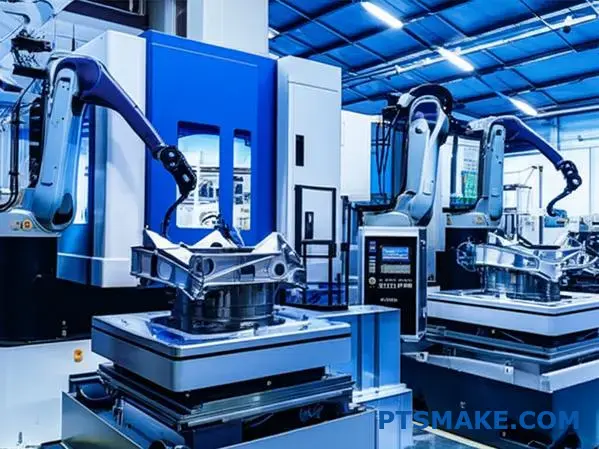
Le paysage de la fabrication en grande série évolue rapidement. Ces progrès ne sont pas seulement théoriques ; il s'agit d'outils pratiques dont nous commençons à voir les résultats tangibles.
Optimisation des processus pilotée par l'IA
L'automatisation alimentée par l'intelligence artificielle n'est plus de la science-fiction. En effet, en l'usinage CNC en grande sérieLes algorithmes d'IA analysent en temps réel de grandes quantités de données provenant des capteurs installés sur les machines. Cela permet d'ajuster de manière autonome les vitesses de coupe, les avances et les trajectoires d'outils, maximisant ainsi l'efficacité et minimisant l'usure des outils. L'IA est également utilisée pour la maintenance prédictive, qui nous avertit des défaillances potentielles des machines avant qu'elles ne se produisent, évitant ainsi des temps d'arrêt coûteux. Il s'agit de passer d'une résolution réactive des problèmes à une optimisation proactive, un concept qui est également à l'origine d'innovations telles que les systèmes de gestion de l'information. conception générative8. Cette approche intelligente garantit une qualité et un rendement constants, ce qui est essentiel pour les grandes séries de production.
| Aspect | Usinage traditionnel | Usinage amélioré par l'IA |
|---|---|---|
| Contrôle des processus | Ajustements manuels par les opérateurs | Optimisation autonome en temps réel |
| Maintenance | Programmée ou réactive | Prévisionnel et proactif |
| Assurance qualité | Contrôles ponctuels post-production | Contrôle et correction en cours de processus |
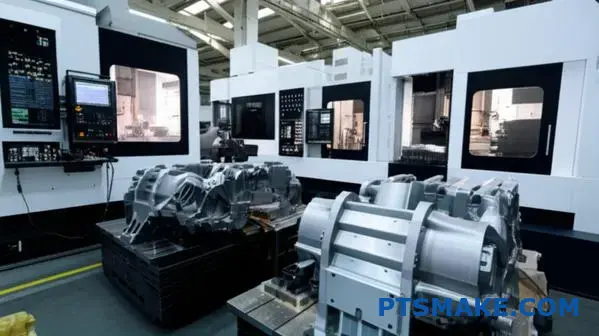
Au-delà de l'amélioration de l'intelligence des processus, l'avenir consiste également à les rendre plus intégrés et plus responsables. Nous assistons à une convergence des technologies et à une prise en compte croissante de l'impact environnemental.
Systèmes hybrides et fabrication écologique
L'un des développements les plus intéressants est la fabrication hybride, qui combine les processus additifs (comme l'impression 3D) et les processus soustractifs (l'usinage CNC) en un seul système automatisé. Cela nous permet de créer des pièces très complexes avec des canaux internes ou des structures légères en treillis, puis d'usiner les surfaces critiques avec des tolérances serrées, le tout sur une seule machine.
Pratiques respectueuses de l'environnement
La durabilité devient également un moteur essentiel de l'innovation. Chez PTSMAKE, nous explorons activement des solutions respectueuses de l'environnement avec nos clients. Ces solutions comprennent l'utilisation de métaux recyclables, la mise en œuvre de machines à haut rendement énergétique et l'adoption de fluides de coupe biodégradables. Ces pratiques écologiques permettent non seulement de réduire l'empreinte écologique d'une entreprise, mais aussi de réaliser d'importantes économies grâce à la réduction des déchets et de la consommation d'énergie, ce qui présente un double avantage.
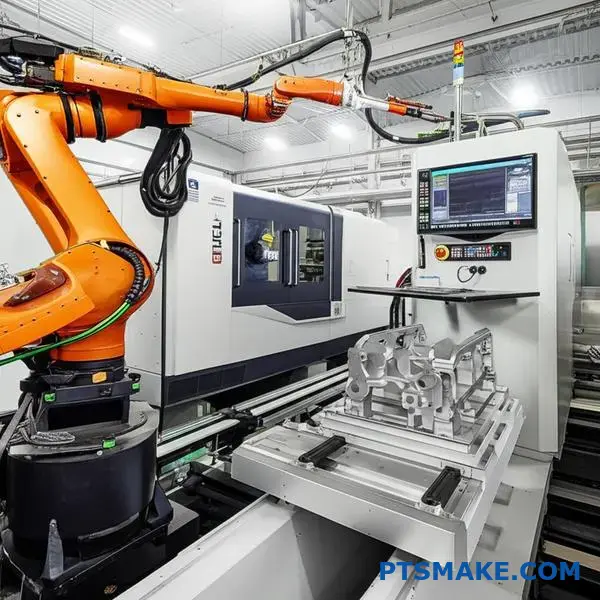
L'avenir de l'usinage CNC en grande série est défini par des solutions intelligentes, intégrées et durables. L'optimisation pilotée par l'IA améliore l'efficacité et évite les temps d'arrêt, tandis que la fabrication hybride et les pratiques écologiques offrent un avantage concurrentiel distinct en permettant des conceptions complexes et en réduisant les coûts opérationnels.
Comprenez comment l'optimisation du temps de cycle a un impact direct sur vos coûts de production et votre rapidité de livraison. ↩
Découvrez comment cette mesure critique garantit la précision de chaque pièce sur l'ensemble de votre production en grande série. ↩
Découvrez comment le suivi du parcours d'un matériau, de son origine à la pièce finale, garantit la qualité et la conformité dans des secteurs de fabrication critiques. ↩
Comprendre la science de la mesure et son rôle essentiel dans la précision de la fabrication. ↩
Découvrez comment le calcul de cette mesure peut vous aider à prévoir les pannes d'équipement et à optimiser efficacement votre programme de maintenance. ↩
Comprendre comment les propriétés des matériaux peuvent varier en fonction de la direction, ce qui est essentiel pour concevoir des pièces composites solides et fiables. ↩
Découvrez comment une métrologie précise est essentielle pour garantir la qualité et la cohérence de milliers de pièces usinées. ↩
Découvrez comment les algorithmes d'IA génèrent des conceptions de pièces optimales en fonction des exigences de performance, des matériaux et des méthodes de fabrication. ↩


